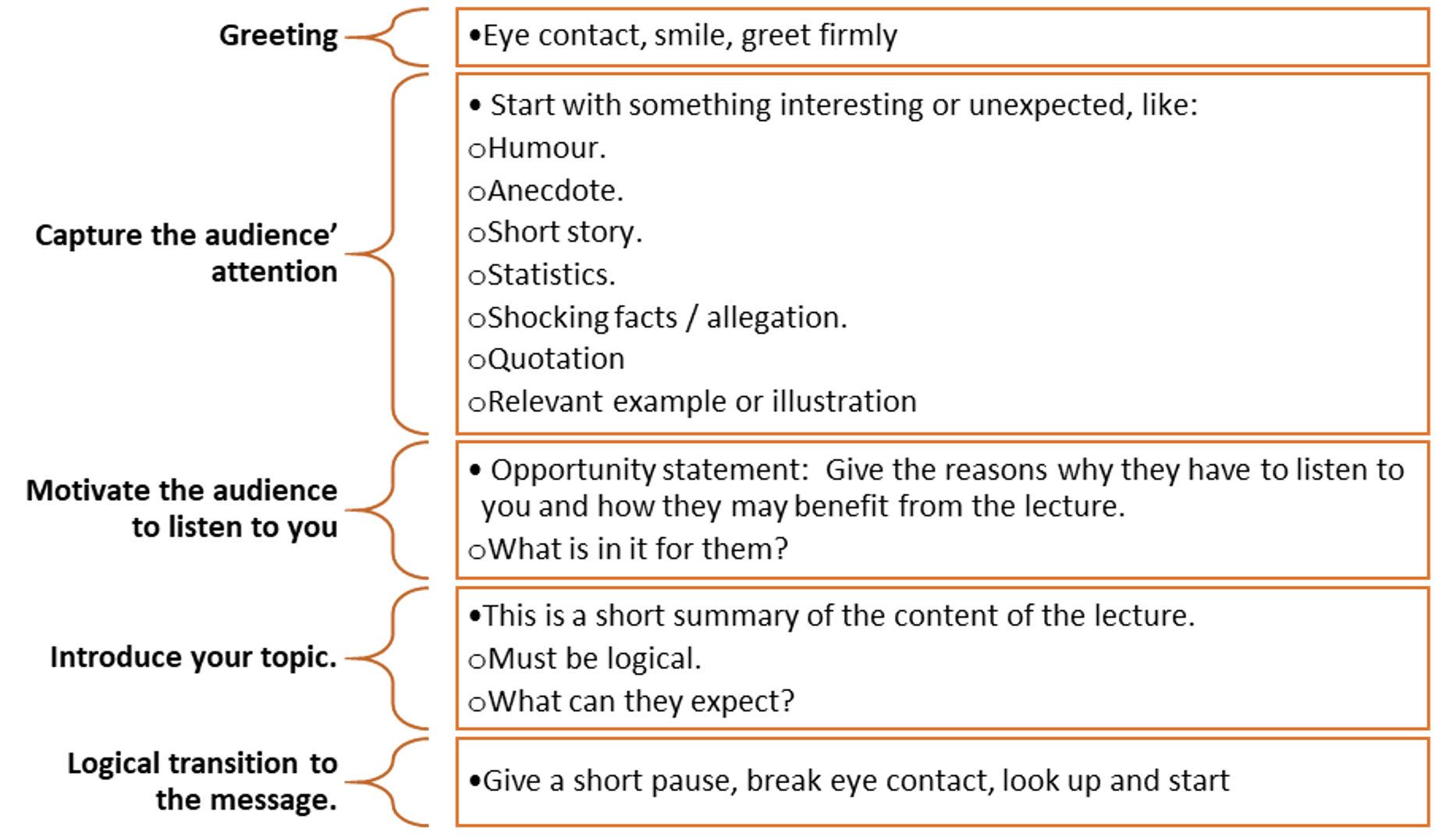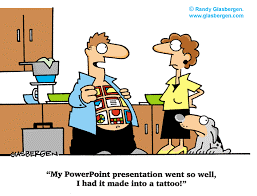Presentations
It is inevitable that at some time you will be faced with the challenge of giving a presentation or a speech. The more successful you are, the more frequently this will arise; the better you present, the more successful you will become. The ways and means of compiling and delivering excellent presentations are not a secret, passed down from father to son.
As you will see in our time together, it is not difficult to learn what is needed. It is indeed a little more challenging to perfect the skills (to ride the bicycle with ease and grace), but you could take comfort from the fact that whatever effort you choose to put into practising will be rewarded with enhanced capability and recognition of this growth by important people in your life and career.
A presentation is not a speech, nor is it a training session; it falls between these two. We tend to think of a speech as an occasion for someone to stand up in public and make an announcement or say a “few kind words” in a tribute or a dedication. Politicians make speeches. Presentations, however, are speeches that are delivered in a business, technical, professional or scientific environment, usually accompanied by the use of visual aids. The topic of a presentation, as we will describe later in more detail, is likely to be one of: persuading, challenging, informing, instructing or delivering bad news.
The members of the audience are likely to belong to the same organisation or have similar professional interests as you. Training, by contrast, is a presentation with a focus on learning by means of modifying in some way the participants’ knowledge, skills or attitudes.
Being able to give a good presentation is an indispensable part of a successful career. As soon as one achieves a level of authority in an organisation, it becomes necessary to develop subordinates and to motivate and manage performance. At higher levels, one has the opportunity to present new ideas and to influence products, processes, policies, procedures and strategies within the company. It is a well-known fact that giving speeches and presentations is something that fills many people with fear, but the best medicine for such fright is the confidence that arises from having thoroughly prepared and practised beforehand.
Click here to view a video that explains how to give a great business presentation.
Step 1: Know Your Objective
If you are not clear about what you want to accomplish with your presentation, you are guaranteed to produce a vague and embarrassingly inept performance. Define what you want your audience to do as a result of your presentation. There are five main purposes for the presentation:
Persuading: influencing opinions/urge people to adopt a certain line of action
Challenging: reveal what people must face up to/dare to do
Informing: update people with news/facts
Teaching: Training or coaching, giving instruction
Giving bad news: reveal bad news
Yet, your objective will still be that they do something as a result of attending the presentation. Specifically, what do you want to achieve?
Try to narrow down your objective to one single strong sentence – that spell out exactly what it is that you want to achieve.
Step 2: Know Your Audience's Objectives

For this try and get inside the mind of your audience.
It appears that a large crowd of people packed together in one place achieves two important results that still cannot be achieved so well by any other means: the affirmation of unity and solidarity and the acclamation of leadership.
This is not true of small gatherings, but as they grow larger it becomes more and more true. A really large audience is not, for most practical purposes, a place for detailed and reasoned argument. The more people there are, the smaller the proportion whose knowledge, experience, intelligence and interest are at the right level and the harder it is for the argument to be comprehensible and relevant to any but a few.
So you have to appeal not to the diverse minds but to the common emotions – hopes and fears, elation and aggression, admiration and contempt, shared experiences and shared aspirations. When you get so many people together, you are not dealing with the intellectual differences of the individual but with the biological identity of the species. In an audience, we discover our group identity and we accord special prominence and respect to those who lead us to the discovery.
In order to pitch your presentation at the right level and to establish the appropriate language level, you need to identify the type of audience that you will be addressing. Can you speak in a language that is understood by the audience? This is a question you should ask yourself before every lecture. Audience language means- ‘words that the audience use and understand’.
If your audience prefers pictures and simple language, give them exactly that. Other audiences are familiar with technical words, so pitch your lecture at their level of understanding otherwise they may think you are insulting their intelligence.
The characteristics of the audience are extremely important:

Why is the audience there? Why must they attend the lecture?
Obligation: Sometimes we are required to attend lectures or meetings at which we are forced to take a passive role.
To be entertained: Some organisations use speakers more for their entertainment than content value.
To learn: Half the battle is won if you know that the audience is hungry for information.
To pass time: Attending a lecture is often a way of passing time.
To network: Anyone who has attended an industry conference knows that, for most delegates, the lectures tend to be secondary to the networking opportunities.
To impress: Some members use the occasion not to listen and learn but as an arena in which to be noticed.
To manipulate politically: Some will attend and shamelessly try to sabotage your platform for the sake of scoring political points.
Finally, you should be able to formulate another key sentence – the one which expresses the final impression you want to leave in the mind of your audience when the presentation ends.
Click here to download a handout with questions that might be helpful in establishing the objectives of your presentation.
Step 3: Plan Your Approach
Know your topic: When faced with the task of giving a presentation, the first step you need to take in your preparation is to do research. Whether you are an expert in the subject or know only a little about it, you need to do some research to come up with the right material for your lecture.
Plan your approach/style: Presentations tend to fall into 5 broad categories. Preparation of script will differ –depending on the type of presentation that you intend to do.

Persuasion
This type of presentation is designed to influence opinions or urge people to adopt a certain line of action. It could contain the following elements:
- Dramatic facts or statistics to grab attention
- Negative scenario if nothing changes
- Positive scenario if change happens
- Your main ideas (the change which is required) and their supporting arguments
- Anticipated objections and your responses to them
- Description of desired future
- Action plan
Challenge
This type of presentation reveals what people must face up to or dare to do or significantly improve. It could contain the following elements:
- Description of the current situation, in detail as graphic and vivid as possible
- Vision of the desired future, equally as bright and clear
- Steps to be taken
- Action plan
Information
People need to be updated with news, facts, figures, decisions and many other types of information. Such a presentation could contain the following elements:
- Overview of the topic (tell them what you’re going to tell them)
- Main ideas and the supporting arguments (tell them)
- Relevance to the audience (Radio WIIfm)
- Summary and conclusion (tell them what you’ve just told them)
Instruction
This type of presentation is similar to a training or coaching session. Such a presentation could contain the following elements:
- Outcomes
- Learning content delivered in small chunks for easier assimilation and in a logical sequence
- If skills are involved, demonstrate them
- Allow adequate time for practice
- Give feedback during the practising
- Check understanding by asking participants to re-phrase, demonstrate, give their own examples or to prove understanding by any means other than your asking: Do you understand?
- Test against the outcomes
- Indicate in what way their learning is to be used after the presentation
Bad News
If people have to hear bad news, bear in mind:
- Head straight in, don’t beat about the bush
- Be accurate and truthful
- Recognise that what you are saying may cause sorrow, anguish, fear and/or anger and let them know that you acknowledge this
- Outline the way forward and any genuine good news on the horizon
- Be encouraging and supportive
Step 4: Write your Script - Main Ideas
Writing the Script
A presentation plan is an essential piece of equipment for the presenter. It serves to guide you in the correct sequence and ensures that all relevant material is covered during the presentation. It provides a check to see if objectives are being met, if relevant.
Main Ideas
It is fine to start with the body of the presentation first and do the introduction and conclusion later because, once your ideas are developed, you will know what it is you are introducing and concluding! Keeping in mind what it is you want people to do after your presentation, make a list of important ideas in achieving your objective. Categorise your list into main ideas, others which support them and ideas which can be discarded. Two to five main ideas will be enough.
Support each main idea with a few supportive comments. These may be explanations, research data, anecdotes or other relevant ideas which add substance and merit to the main ideas.
You are telling your audience a story and it is important to repeat the main points, for them to remember, throughout the lecture. Use the following guidelines:
- Every point must have a clear beginning, middle and end to it.
- Smooth transition from one point to the next.
- Audience will absorb a limited amount of information, don’t data overload.
- Jokes must be highly relevant.
- Avoid the use of unnecessary words.
- Phrase your ideas in the form of questions.
- Use appropriate analogies and things of an interesting nature.
- Maintain the level of energy and enthusiasm.
- Summarise regularly.
- Fit contents within the allocated time.
|
Main Ideas |
Supporting Arguments for Each Main Idea |
|
|
|
|
|
|
|
|
|
|
|
|
Step 5: Write your Script
Introduction and Conclusion
Now that you know what your presentation is about, you are in a position to introduce and to conclude it!
In your introduction, you have to grab the interest and attention of your audience, (However you should also try to space out additional attention-getters approximately every 10 minutes in the body of your presentation in order to keep both interest and your listeners alive.)
The fact is that every speaker needs some sort of acceptance from the audience: if they are to accept what you say, they need some grounds for believing that you are in most ways the same sort of person as them and that you will present new and interesting perspectives/information on the topic.
Structure of the Introduction

Your conclusion must not introduce new material or ideas. It is a wrap-up of what has gone before – the same ideas but perhaps expressed in different words.
Hillaire Belloc’s famous words: Tell them what you’re going to tell them, then tell them, and then tell them that you’ve told them.
It must clearly summarise the main argument, reinforce the benefits and remind your audience of the first step of the action plan. Try to find a punchy ending for your closing words.
Your closing will include the conclusion, that is, the summary of your argument. However, try to find an inspiring, challenging or moving phrase or sentence as a last thought which also encapsulates whatever it is you originally wanted people to do as a result of attending your presentation.
Hold the silence after your last word, without stepping down or away. Wait for and enjoy the applause and acknowledge it with a simple: Thank you.
Don’t bow even though you may experience a peculiar desire to do so!
